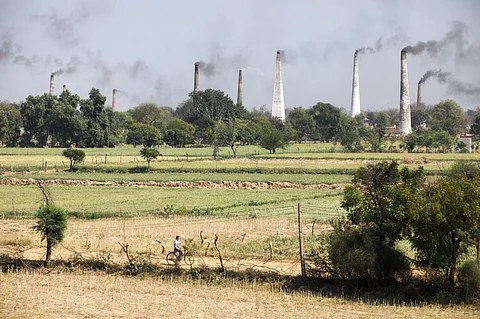

A handful of inexpensive changes in how Bangladeshi brick kilns are run have cut energy use by nearly a quarter and slashed emissions — a breakthrough that could transform one of South Asia’s most polluting industries, a new study has found. The findings may hold promise for similar informal kilns in India.
Just five low cost measures can help brick kilns boost energy efficiency, help slash carbon dioxide and air pollutant levels, according to the paper published in the journal Science.
Tested in 276 brick kilns in Bangladesh, the interventions — which included changes to fuel feeding, kiln insulation, brick stacking and worker incentives — led to a 23 per cent drop in the amount of energy used to fire bricks, leading to a 20 per cent reduction in emissions of carbon dioxide and particulate matter with a diameter of smaller than 2.5 micrometres (PM 2.5).
Brick manufacturing in South Asia is dominated by traditional, coal-fired kilns operating informally, with limited regulatory oversight. These kilns are among the region’s largest sources of greenhouse gases. Prior studies have shown that they also degrade air quality, harm health and reduce crop yields.
Despite efforts since 2009 by international development agencies — including the World Bank, Asian Development Bank and United Nations Development Programme — to modernise the sector through over $150 million in pilot projects, uptake remained limited. The interventions introduced in these projects were often technologically advanced and capital-intensive, making them difficult to scale across the informal sector.
To overcome this, researchers tested five easily implementable operational improvements aimed at reducing fuel consumption and improving brick quality, which could also help kiln owners reduce costs and increase revenue.
Bangladesh was chosen for the study due to its largely informal brick sector, where weak regulation has led to limited improvements over the past three decades.
The team divided the 276 brick kilns into three groups:
A control group, where researchers explained the interventions to 93 kilns but provided no training;
A technical group, where 89 kilns received information, training, and technical support to adopt a set of operational improvements;
A technical+ group, where 95 kilns received all the above support plus explicit guidance on incentivising workers — such as through bonuses or improved working conditions — to encourage adherence to the new practices.
The first intervention involved replacing the traditional method, where two or three firemen simultaneously fed coal every 10-15 minutes, followed by a 15-20 minute pause — with a continuous feeding system. Under the new approach, a single fireman feeds coal steadily for 30 minutes, after which another takes over for the next half hour, creating a continuous cycle.
The older method led to excessive fuel accumulation, limiting airflow and causing incomplete combustion, unburnt coal, and black smoke. In contrast, the new system allows coal to be added in smaller, steady amounts, ensuring sufficient airflow and more complete combustion.
Another measure improved brick stacking techniques. Less dense stacking improved airflow and heat distribution, resulting in better-quality bricks.
A third change increased the ash layer on top of the brick setting from six to nine inches, improving insulation and reducing heat loss.
The fourth intervention thickened the kiln’s entry gates to 30 inches and introduced an ash-filled cavity wall, reducing air leakage and further lowering coal requirements. This practice improved the bricks’s quality.
The final measure replaced coal with powdered biomass — such as sawdust — in the newly lit chamber of the kiln, where temperatures were below 500 degreec Celsius. Biomass burned more efficiently at low temperatures, reducing black smoke and carbon monoxide emissions. Coal was reintroduced once temperatures exceeded 700°C.
Between 2023 and 2024, researchers observed high adoption rates of the intervention. About 66 per cent of kilns in the technical group (59 out of 89) and 64 per cent in the technical+ group (61 out of 95) adopted the new practice. Even in the control group, 20 per cent of kilns (18 out of 92) implemented the intervention.
The adoption rates with and without incentives were roughly the same. “We found that owners in the technical+ arm were no more likely to use incentives than kilns in the technical arm or the control arm (as reported both by owners and workers),” Nina Brooks, assistant professor for global health, Boston University School of Public Health, told Down To Earth.
Training costs amounted to approximately $89,374, or around $486 per treatment kiln. In contrast, the social cost of carbon was estimated at $31,580 per kiln. The training costs were covered by research funds, but questions remain about the project’s long-term sustainability.
Ensuring these changes to kiln operation can be long-lasting and self-sustaining is critical, said Brooks. “While $486 per kiln may seem like a lot, we expect these costs to go down over time,” she said, adding that as social benefits outweighed the costs of training and support by 65-to-1, it is valuable for an external funder to support these costs.
“We are looking for ways to rapidly accelerate the take-up of these practices, as well as long-term adoption — this may involve a mix of external funding (for example, from climate funders, governments and philanthropy) and kiln owners’ self-funding,” she highlighted.
If scaled up nationally, the interventions could cut CO₂ emissions by 2.4 million tonnes over a single brick-firing season — equivalent to a 2 per cent reduction in Bangladesh’s annual emissions. Given that India shares similar kiln designs and informal manufacturing processes, the researchers argued that these measures could be applied there too.
The researchers are seeking partners in India to conduct preliminary studies, aiming to assess current practices, policies, and willingness to adopt changes before implementing these measures.
“Though traditional brick manufacturing across South Asia are the same, there might be differences in operating practices, soil and fuel quality, as well as government policies,” Sameer Maithel, Founder Director, Greentech Knowledge Solutions Private Limited, told DTE.